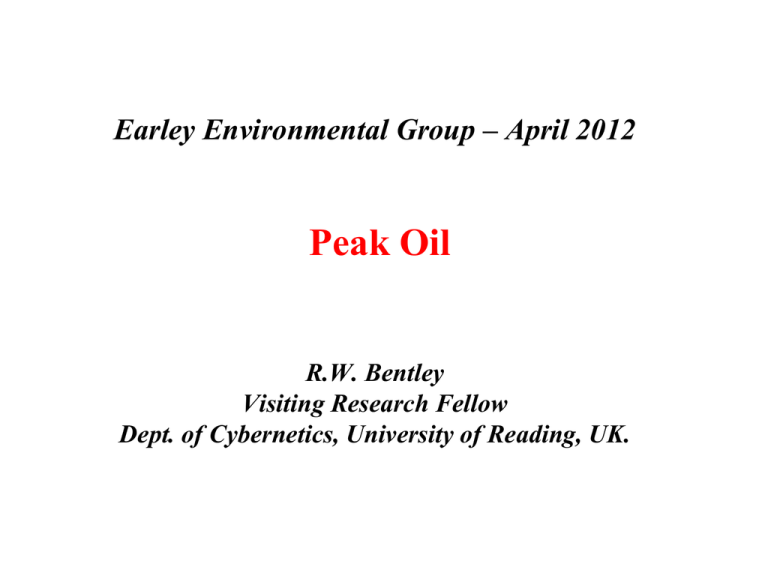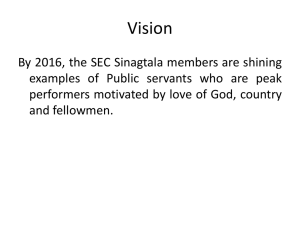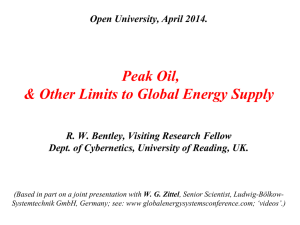Powerpoint slides - Earley Environmental Group
advertisement

Earley Environmental Group – April 2012 Peak Oil R.W. Bentley Visiting Research Fellow Dept. of Cybernetics, University of Reading, UK. Summary of Presentation 1. 2. 3. 4. 5. 6. 7. Oil price & The conventional oil peak Why does oil production in a region peak? Peak is counter-intuitive Past forecasts – were they really wrong? Data by country (see note, below) There is a lot of oil & ‘nearly-oil’ - but Current forecasts - the conventional oil peak is likely to dominate. 8. The views of DTI / BERR / DECC 9. Conclusions on Peak Oil 10. What to do? Note: In the public presentation proprietary data were shown for Russia, Iran, Iraq & Saudi Arabia. These data are excluded from this file so that it may be freely distributed. The University of Reading, UK ‘Oil Resources Group’: Past & present Postgraduate Research Institute for Sedimentology Prof. M.L. Coleman (ex-BP), Prof. B.W. Sellwood. Department of Engineering Dr. J.D. Burton, Mr. R.H. Booth (ex-Shell), Dr. R.M. Mayer (ex-BP), Prof. P.D. Dunn, MSc. students (also City University). Department of Cybernetics Dr. G.R. Whitfield, Dr. R.W. Bentley (ex-Exxon). Affiliated: Dr. D. Fleming, independent economist. - For many years the only UK academic group doing quantitative research on future global hydrocarbon supply. Oil price 1911 - 2010 120 Money of the day 100 Adj. for inflation $/barrel 80 60 40 20 0 1911 1921 1931 1941 1951 1961 1971 1981 1991 2001 2011 Data source: BP Statistical Review 1. Oil price 1911 - 2010: Adjusted for inflation, over the last century the price was as high as today’s only during the ‘oil shocks’ of the 1970s. Those resulted in stagnant economies, global inflation, high levels of unemployment, and large developing-country debt. Oil Production and Price Source: Murray / King comment in Nature Source: Murray, J. and King, D. (2012) Oil’s Tipping Point has Passed, Nature, Volume 481, 433-435 Crude Oil Price versus Crude Oil Production from 1998 to present Murray / King comment in Nature Source: Murray, J. and King, D. (2012) Oil’s Tipping Point has Passed, Nature, Volume 481, 433-435 Conventional Oil Supply and Demand - The Conventional oil peak is about now. Murray / King comment in Nature Volume of conventional oil discovered Volume of conventional oil consumed Forecasted demand 1.2% p.a. growth Billions of barrels [Gb] 50 40 30 20 10 0 1900 1920 1940 1960 1980 2000 Year 2020 2040 2060 Source: N.A. Owen, O.R. Inderwildi and D.A King, ‘The status of conventional world oil reserves - Hype or cause for concern?’ (2010) Energy Policy, doi:10.1016/j.enpol.2010.02.026 2. Why does conventional oil prodn. in a region peak? Simple model: Discovery, then production - big fields first. Annual Discovery & Production (arbitrary units) 100 Fields take 5 years to get into production 80 Discovery 60 Production 40 20 0 -4 -1 2 5 8 11 14 17 20 23 26 29 32 35 38 41 Years 3. Conv. oil peak is counter-intuitive. It occurs when production is rising, reserves are large, new fields are being discovered, & technology is increasing recovery factors. Annual Production (arbitrary units) 50 What to forecast at year-10? 40 30 20 Produced Reserves Yet-to-find 10 0 1 3 5 7 9 11 13 15 17 19 21 23 25 27 29 31 33 35 37 39 41 Years Validity of this model This general model of peak is borne out by the ~60 countries now past their conventional oil peak. (See R. Bentley: An Explanation of Oil Peaking.) A Note on Oil Reserves - Bad data & Good data Public-domain proved reserves (‘1P’) For oil forecasting these are atrocious data: - under-reported, over-reported, not reported. Industry proved plus probable reserves (‘2P’) Must use 2P data to assess future production Data: from oil field owners & operators; also IHS Energy,Wood Mackenzie, PFC Energy, Data Monitor (was Energyfiles), etc.; also IFP, BGR. (See: R.W. Bentley, S.A. Mannan, and S.J. Wheeler. Assessing the date of the global oil peak: The need to use 2P reserves. Energy Policy, vol. 35, pp 6364–6382, Elsevier, 2007). Difference between ever-growing global proved reserves (‘1P’, magenta) and diminishing proved+probable (‘2P’, green). World remaining oil reserves from political and technical sources 1400 including tarsands +175 Gb remaining reserves Gb 1200 omission of probable 1000 incorrect aggregation 800 OPEC fight for quotas +300 Gb = speculative resources al-Husseini (Aramco) 600 Ghawar 400 technical = 2P = proven+probable = backdated mean excluding extra-heavy oil political = 1P = current so called proved 200 0 1940 Jean Laherrere 2008 1950 1960 1970 1980 1990 2000 2010 yearSources: IHS, USDOE, CAPP, OGJ The use of proved reserves by most analysts, and the assumption by many that this is all the oil a region can still produce, have been major failings. 4. Past oil forecasts – Were they really wrong? • So often said: “Can’t trust oil forecasts - thirty years ago we were told we had only 30 years’ of oil left; now we have 40 years’ left!” But the ‘30 years’ of oil was only that in proved reserves. This omitted the large amount of oil in probable reserves, and in ‘reserves growth’ due to technical improvement, and in the yet-to-be-discovered. In the 1970s, calculating peak from this total expected amount of oil put the global production peak (not global exhaustion) around the year 2000. Demand reduction due to ‘73 & ‘78 oil shocks moved this peak to ~2010. Estimates for date of World peak, 1956 - 1981 Peak Date/Author Methodology Ult. (Gb) Yr. Mb/d ‘56 Hubbert Ult. from Weeks (mod.); hand-drawn curve 1250 ~2000 35 ‘69 Hubbert Logistic curve 1350 1990 65 ditto 2100 2000 100 ‘72 ESSO ? * “increasingly scarce from ~ yr. 2000” 2100 * ‘72 Ward & Dubois ? [Report to the UN.] 2500 ~2000 ‘76 UK DoE ? ~2000 ‘77 Ehrlich ? 1900 2000 ‘77 Hubbert Ult. from Nehring: Logistic (unconstrn’d.) 2000 1996 100 Demand flat from 1974 ditto 2035 [ Actual demand between these two cases.] ‘79 Shell ? ** “plateau within next 25 years” ** ‘79 BP ? Non-communist world, ex NGLs. ? 1985 [ Actual demand fell, Ult. about right. ] ‘81 World Bank ? *** “plateau from around turn of century” 1900 *** ? = Not known; probably mid-point peaking. Others gave estimates for oil ‘ultimate’, but did not carry through to a peak date: SPRU, UK: 1800-2480Gb; WEC/IFP: 1803 Gb; D. Meadows et al.: 1800-2500 Gb. So: Past oil forecasts – Were they really wrong? • No, we have had plenty of warning from well-recognised bodies since the 1950’s that the peak in global conventional oil production was expected around 2000 2010. (R.W. Bentley and G.A. Boyle. Global oil production: forecasts and methodologies. Environment and Planning B: Planning and Design, vol. 35, pp 609-626, 2008.) 5. Industry Data – by country: Graphs of: - Proved & probable (‘2P’) oil discovery - Oil production for Germany, UK, US, & the World; where ‘oil’ includes NGLs, but not oil from tar sands, shale oil, oil shale, GTLs, CTLs or biofuels. Note: These data are proprietary to IHS Energy & Energyfiles Ltd., but permission has been given for publication. 1900 1906 1912 1918 1924 1930 1936 1942 1948 1954 1960 1966 1972 1978 1984 1990 1996 G b /year G erm any - Liquids,AnnualProduction 0.07 0.06 0.05 0.04 0.03 0.02 0.01 0.00 Discovery Production 1995 1989 1983 1977 1971 1965 1959 1953 1947 1941 1935 1929 1923 1917 1911 1905 Pre- Gb / year Germany - Liquids, Annual data 0.5 0.4 0.3 0.2 0.1 0.0 Germany - Liquids, Cumulative data 2.5 Prod. at peak 0.72 Gb Campbell Ult. 2.40 Gb 2.0 Peak percent 30 % 1.0 0.5 2027 2019 2011 2003 1995 1987 1979 1971 1963 1955 1947 1939 1931 1923 1915 1907 0.0 Pre- Gb 1.5 Discovery Prodn. Peak USGS; Mean, no RG Campbell USGS; 5% +RG UK Oil Production by Field Source: LBST, Germany 2006 160 Production in [milllion m³] 140 Fore cas t 120 100 80 60 40 20 1975 1980 1985 Ludwig-Bölkow-Systemtechnik GmbH, 2007 Source: DTI, May 2007; Forecast: LBST 1990 1995 2000 2005 2010 Predicting peak is not hard – the case of the UK. Once 2P discovery has declined (~1978 in UK), the date of peak is pretty well known. Discovery Production 1995 1989 1983 1977 1971 1965 1959 1953 1947 1941 1935 1929 1923 1917 1911 1905 Pre- Gb / year USA - Annual data 16 14 12 10 8 6 4 2 0 USA - Cumulative data 500 400 110 Gb Campbell ~Ult. 260 Gb Peak percent 42 % USGS, P5% +RG 402 Gb Peak percent 200 27 % 100 2027 2019 2011 2003 1995 1987 1979 1971 1963 1955 1947 1939 1931 1923 1915 1907 0 Pre- Gb 300 Prod. at peak Discovery Prodn. Peak USGS Mean, no RG Campbell, est. USGS, P5%, +RG World - Liquids, Annual data Discovered: 2033 Gb Produced: 934 Gb Percent: 46 % 160 140 100 80 60 40 20 Discovery Production 1995 1989 1983 1977 1971 1965 1959 1953 1947 1941 1935 1929 1923 1917 1911 1905 0 Pre- Gb / year 120 World cumulative plot - 2P discovery trend vs. est’d. ‘ultimates’ - High estimates of global URR do not match 2P discovery trend. Oil + NGLs 2P discovery & prod’n., 1900-2000. Source: IHS Energy, 2001. World - Liquids, Cumulative data Prod. at peak: n/a Gb 5000 Campbell Ult. (+polar, deep, NGLs) ~ 2300 Gb 4000 2000 1000 Dis covery Prodn. Peak USGS; Mean +RG, NGLs Cam pbell: +NGL, deep, polar USGS; 5% +RG, NGLs 2025 2018 2011 2004 1997 1990 1983 1976 1969 1962 1955 1948 1941 1934 1927 1920 1913 1906 0 Pre- Gb 3000 6. There is a lot of oil & ‘nearly-oil’ - Source: IEA 7. Current Forecasts – The conventional oil peak is likely to dominate Forecasts from 2010 World - other oil supply Refinery Gain Gas-to-Liquids Coal-to-Liquids Biofuels 20000 18000 Barrels (000s) of oil per day 16000 14000 12000 10000 8000 6000 4000 2000 0 1950 1960 1970 1980 1990 2000 Year Forecasts from 2010 2010 2020 2030 2040 © 2050 globalShift Forecasts from 2010 Top-down or bottom-up? Source: R Miller The top-down picture shows what has happened globally, but not why The bottom-up picture shows why things happen. Large fields start earliest, enter decline, and new fields cannot compensate IEA, WEO 2011 The UK bottom-up model Source: R Miller • Fallow fields are probably uneconomic • Declared projects: expect delays • YTF is estimate • Clair and Schiehallion may give brief respite Key all-oil risks and projections to 2040. Oil sands reach 9.5 Mb/d. “Saw-tooth” and prices are concepts, not projections. Source: R. Miller Growth at 1% CAGR Source: Miller & McGlade 7 10 x 10 9 8 7 Production (b/d) 6 5 4 3 Producing Fallow Undiscovered Mined bitumen In situ bitumen Demand at 1% CAGR 2 1 0 1995 2000 2005 2010 2015 2020 2025 2030 2035 2040 The future supply challenge Source: Peak Oil Consulting Supply and Demand to 2020 Source: Peak Oil Consulting 105000 100000 95000 90000 85000 80000 2006 2007 2008 2009 Usable Capacity 2010 2011 EIA Trend 2012 Supply 2013 2014 2015 IEA Medium Term 2011 2016 2017 Demand 1.6% 2018 2019 2020 UKERC Global Oil Depletion report, Oct. 2009. UK Energy Research Centre - Technology and Policy Assessment report. Authors: Steve Sorrell, Jamie Speirs, Adam Brandt, Richard Miller, Roger Bentley. “What evidence is there to support the proposition that global demand for conventional oil will be constrained by physical depletion before 2030?” * *Conventional oil: crude oil, condensate and natural gas liquids (NGLs) Comparison of Oil Forecasts – The ‘Miller’ plot Date of peak vs. post-peak decline and ult. recoverable resource UKERC Report: Main Finding - A global peak is likely before 2030 and there is a significant risk of a peak before 2020. 8. Views of DTI, BERR, DECC The University of Reading ‘Oil Group’ variously told that: • “Oil is not important to the UK economy - it takes a declining share of the energy mix, and now represents only a small percentage of the UK's GDP. ” • “Not likely to be problem, but even if there were a risk, then the market is the best solution.” • “The IEA's 'Resources into Reserves' report discounts any medium-term supply problem: there are more than enough conventional oil resources for well over 40 years of world supply.” More recently BERR said: • “The world has just found a giant field – Tupi; implying that oil peaking calculations are unduly pessimistic.” 9. Conclusions on Peak Oil - Cheap conventional oil has almost certainly peaked, (as forecast in Campbell/Laherrère ‘The End of Cheap Oil’, Sci. Am., Mar. ‘98). - A world economy with indebted governments and highlyleveraged institutions is fragile vs. increases in energy cost. - But ‘all-oil’, incl. shale oil, oil shale, GTLs, CTLs and biofuels (and provided price stays high, and aboveground constraints stay moderate ) can yield a great deal of oil. (Forecasts from Smith, Miller, etc. put the ‘unconstrained all-oil’ peak close to 2030; tho’ such production is unlikely due to cost, price impact on demand, politics, & other factors.) Conclusions contd. We are now therefore in an uncomfortable, risky, oil world: - prices will be volatile, and high on average, further damaging economies; - net energy returns are falling; - the decline in pre-peak suppliers increases above-ground risk. Had we heeded the forecasts of the conventional oil peak we could have been much better prepared. 10. What to do? Some actions: a). Modelling b). Demand reduction / Alternatives c). Beware carbon emissions Actions: a). Modelling The main question we need to ask: - Given the fossil fuel global production-rate limits (of oil and gas, and probably coal), and the danger of rapid climate change, are we faced with societal collapse, or can we transition smoothly to the sunny uplands of renewable energy? - No-one, as far as I know, is modelling this correctly. - It would seem useful to have an answer. Modelling: Arup’s ‘4see’ energy / economy model Actions: b). Demand Reduction / Alternatives - R. Mayer: Reducing mismatch between demand and supply Recover energy from drive lines that is currently wasted, such as: • Inertial energy of vehicles when braking • Inertial energy of shipping containers when lowered by RTG cranes Vehicle Efficiency EU standards, etc. Identify applications where oil can be substituted by other fuels, such as: • Oil heating by ground-source heat pumps • Oil electricity generation by renewable energy sources • Diesel/petrol drive lines by electric drive lines in vehicles (rail & road) Use energy storage to smooth mismatch between demand and supply so enabling prime mover to be downsized february 2012 peak oil discussion Rayner Mayer Demand Reduction contd. Transforming the market for oil saving & non-oil products Market transformation process •Establish the benefits and costs through publically funded demonstrations •Provide incentives for change •Inform and educate the public (Example: Switch to lead-free petrol (1983 to 1993) •Gained acceptance of motor industry •Introduced an incentive of 5p reduction per gallon in lead-free •Educated all school children in the dangers of leaded petrol and what parents needed to do to switch to lead-free petrol •Sustained campaign to inform public via press and TV over a 10 year time period) february 2012 peak oil discussion Rayner Mayer Actions: c). Beware carbon emissions of alternatives J. Leggett: Unburnable carbon Thank you for your attention









